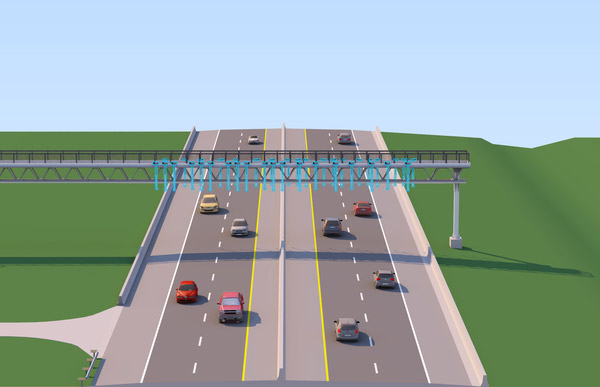RS&H Helps Florida’s Turnpike Turn to All-Electronic Tolling

The ticketing system that has tolled Florida’s Turnpike from Palm Beach to Osceola Counties will soon be a memory. So, too, will be the traffic snarls brought on by vehicles waiting to pass through the 19 existing toll plazas.

RS&H has redesigned the 148-mile corridor to accommodate all-electronic tolling. The project includes demolition of the two existing mainline plazas and 17 ramp plazas in the corridor, as well as the construction of 12 new mainline toll sites. The new mainline toll sites will allow free-flow travel conditions by utilizing gantries designed to accommodate both the current four-lane configuration, as well as the ultimate eight-lane configuration.
“The conversion of the 148-mile-long legacy ticket system is a vital step in the Turnpike’s system-wide transition to all-electronic tolling,” said Florida’s Turnpike Enterprise Work Program Administrator Paul Satchfield.
The numbers of the project are staggering. The Phase III submittal included 4,210 plan sheets, 23 design reports and calculation packages, and 25 KMZ files. The submittal package was so large that the RS&H team had to hand-deliver an external hard drive to the client. Due to the length of the corridor, the team needed to coordinate with seven adjacent resurfacing projects, three widening projects, an active PD&E project, three local drainage districts, two water management districts, and six counties. One of the most impressive numbers: The RS&H team completed this complex design and coordination effort meeting the Turnpike’s 16-month design schedule.
“It was a very aggressive design schedule,” said RS&H Project Manager Nicole Jeffers, PE. “When you spread a project out over nearly 150 miles, it takes a lot of coordination between the counties and municipalities, our subconsultants, FDOT (Florida Department of Transportation) and FTE (Florida’s Turnpike Enterprise). It was a big effort.”
One Big Project = Several Mini Projects
This Turnpike project stretches from the Lantana Mainline toll plaza (MP 88) in Palm Beach County to the Three Lakes Mainline toll plaza (MP 236) in Osceola County for a total of 148 miles. With notice to proceed in hand in October 2017, Jeffers embarked on a daunting task of developing construction plans to successfully implement the AET conversion of the entire corridor on a single night.
“In addition to the design complexity that results from a project with 29 different work sites spread out over 148 miles, there was also a tremendous amount of coordination required with ongoing design projects and other agencies,” Satchfield said. “The entire project team should be commended for completing the design in just 16 months.”
To accomplish such a herculean task on the tight 16-month timeline, RS&H designers attacked each toll location as its own mini project.
“Removing toll booths may seem simple, but you’ve got to rehab the roadway to operate without the toll plaza sitting there,” Jeffers said. “Once you do that and have traffic flowing freely, you’ve got to correct the roadway and everything that goes with it – drainage, lighting, etc.”
Keeping Traffic Moving
To complicate the project, Florida’s Turnpike is identified as a hurricane evacuation route. Evacuation routes in Florida now require a 10-foot-wide shoulder on the northbound lanes so traffic can use the additional pavement as an extra lane in emergency situations. This requirement moved into effect after the design began, which necessitated the design of 70-mph diversions to route traffic around every plaza site during construction.
“It was pretty complicated work to get these designed,” Jeffers said. “We had to completely revamp our approach to maintaining traffic. But the new requirement ultimately benefits the job sites because it moves traffic out of the way for construction of the gantries.”
As a result, construction workers get a bit more space to work, making for a safer job site.
Perfect Timing
Construction on the all-electronic tolling gantries will begin in August, with each of the new toll sites taking between four to eight months to complete. They will all go live over the course of the same evening.
“Being that it is a ticketed system and that all the tolls are connected, the conversion to all-electronic tolling has to happen in a single night,” Jeffers said. “We’ve set up the plans for each site, sequenced in such so that everyone knows what needs to happen before implementation, plus the night of implementation.”
Once the new gantries are activated, demolition will begin on the existing gantries on the exit ramps and toll plazas that bookend the 148-mile corridor.
